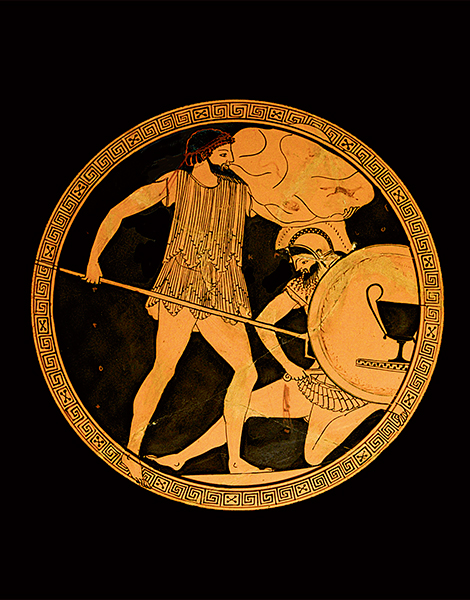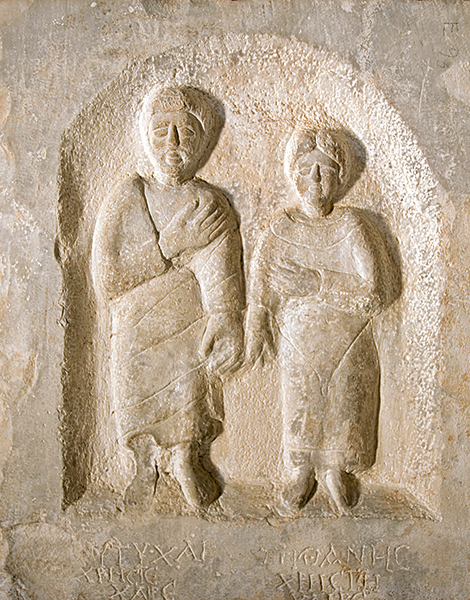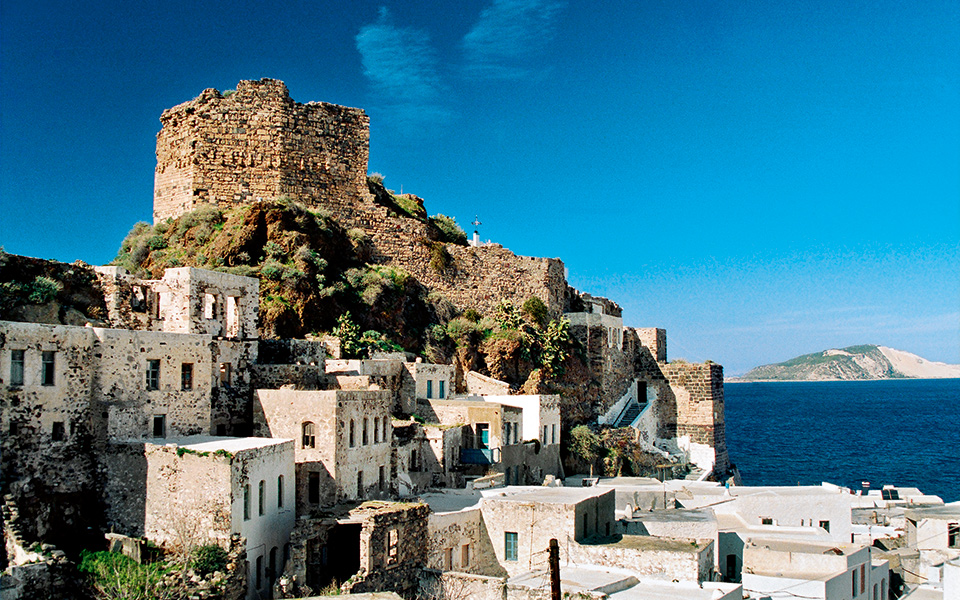According to ancient mythographers, Nisyros was created by the god Poseidon during his battle with the giant Polyvotis, whom he pursued until he came to the island of Kos. Using his trident to break off and hurl a fragment of Kos, Poseidon crushed Polyvotis under the rock’s weight. That rock, the myth says, is Nisyros. The island has been inhabited since Neolithic times. A Cycladic figurine now in the Berlin Glyptothek is said to come from Nisyros, and a later Minoan presence is confirmed by the discovery, at the Palace of Zakros in Crete, of a beautiful chalice made of a single piece of obsidian from the island of Yiali, adjacent to Nisyros.
The earliest written mention of the island occurs in Homer’s “Iliad” (8th c. BC), in which we learn that Nisyros contributed ships to the expedition against Troy (1184 BC), under the command of the rulers of Kos, Pheidippos and Antiphos. Soon after the collapse of the Mycenaean civilization, Nisyros appears to have been overrun by a new wave of Greeks from the mainland, the Dorians. The ancient historian Herodotus identified the 5th c. BC inhabitants of Kos, Nisyros and Calymnos as Dorians from Epidauros in the Peloponnese. The colonists who settled in the southeastern Aegean formed a “Dorian Hexapolis,” of which Nisyros was regarded as a partner. By this time, Nisyros had at least one town, a harbor, thermal baths, and a temple dedicated to Poseidon. The city was located in the area of the modern town of Mandraki, beneath the ancient acropolis of Palaiokastro.
During the Persian Wars, Nisyros fought on the side of King Xerxes and took part, under the command of Queen Artemisia of Halicarnassus, in the Battle of Salamis in 480 BC. After the formation of the Delian League, Nisyros became a tributary ally of the Athenians, contributing troops and funds during the Peloponnesian War. Following the victory of Sparta at Aigos Potamoi in 405 BC, the island briefly joined the Spartan side, until the Battle of Cnidos in 394 BC, when the Athenian admiral Conon temporarily re-established his city’s hegemony in the area.

© Visualhellas.Gr

© Ministry Of Culture & Sports/Ephorate Of Antiquities Of Dodecanese
Alexander the Great claimed sovereignty over Nisyros and the surrounding islands in 334 BC. Macedonian Rule was welcomed as a necessary imposition of order in the region by a Hellenic power. Around 200 BC, Nisyros joined the Rhodian Peraia, an alliance of Greek regional states under Rhodian hegemony. When the forces of King Phillip V of Macedon attempted to subdue the Rhodian allies, the Nisyrian admiral Gnomagoras helped to defeat them.
In 41 BC, Nisyros was sacked by Anthony and Cleopatra after the battle of Pharsala, because its inhabitants disobeyed them. Under Emperor Vespasian (AD 67-69), the island belonged to the Roman “provincia insularum.” Extensive Roman baths, parts of which are still visible, were constructed near the present-day harbor town of Paloi.
With the foundation of Constantinople in AD 330, Nisyros became an integral part of the Byzantine Empire. The island was administered as part of the Byzantine “theme” of Samos. After 1082, when Emperor Alexios Comnenos offered the Venetians privileges in the eastern Aegean, they began exerting significant influence in the area. During the Fourth Crusade, the Byzantine governor of Rhodes, Leon Gavalas, declared independence and fortified Nisyros. In 1246, after Gavalas was succeeded by his brother Ioannis, the islands were re-incorporated into the Byzantine Empire. Following a brief occupation by Genoese forces and their subsequent expulsion by Emperor Michael Palaiologos, Nisyros fell under the protection of the Knights of Rhodes, who took possession in 1315. What followed was a period of occupation by a succession of forces belonging to Western aristocrats. A popular insurrection took place in 1352 against the Italian master of Nisyros Novello Manocca da Ischia.
Immediately after the Fall of Constantinople in 1453, Nisyros was fortified by the Knights in anticipation of massive Ottoman attacks. In 1455, an Ottoman fleet led by Hamza Bey attacked Nisyros and carried off many of its inhabitants, selling them into slavery. The island was again overwhelmed in 1457 by an Ottoman fleet. In 1471, the Grand Magistrate of Rhodes Giovanni Battista de Orsini, in whose charge Nisyros had been placed, handed the island over to the Catalan Knight Galcerano da Lugo, with orders to prevent the Ottomans from returning.
“Alexander the Great claimed sovereignty over Nisyros and the surrounding islands in 334 BC. Macedonian Rule was welcomed as a necessary imposition of order in the region by a Hellenic power.”

© Artin Karakasian
Suleiman the Magnificent wrestled the eastern Aegean islands from the Knights in 1522. Because it willfully submitted to Suleiman, Nisyros was granted a degree of autonomy and was not settled by Turks. However, Turkish rule was severe and was intended to eradicate the local religion and cultural identity. Substantial privileges were bestowed on natives who would convert to Islam and follow Turkish language and customs. A head tax (the “maktou”) was imposed on Christians and Islamized men who re-embraced the Christian faith were put to death by dismemberment or beheading. One 15-year old Nisyrian by the name of Nikitas Karmiris suffered such a fate in 1754, and was later canonized as Aghios Nikitas.
In the second half of the 18th c., Nisyros and the other islands experienced a relaxation of Ottoman authority, thanks to the Russo-Turkish War (1769-1792), during which Empress Catherine forced the Ottomans to ease their control over the Greek Orthodox population. Nisyros played an active role in the Greek Revolution of 1821 by supplying men for the fleet of Admiral Andreas Miaoulis. The Dodecanese islands enjoyed a short period of freedom in 1823 as a part of the “Temporary Administration of Hellas,” but after the London protocols of 1829 and 1830, they were required once again to submit to Ottoman rule, albeit in exchange for special privileges. After the Young Turks’ Revolution of 1908, these privileges were cancelled.
Turkish rule ended in 1912, when the Dodecanese were seized by an Italian fleet after Italy had annexed North African territories controlled by Turkey. Though welcomed at first as liberators, the Italians soon began to transform the islands into permanent colonies. In 1923, the Treaty of Lausanne stipulated that Turkey permanently cede the islands to Italy. Native resentment toward the Italians grew with the introduction of harsh taxation, the nationalization of Greek businesses, and the denigration, in 1937, of the Greek language to the status of a regional tongue.
Following Italy’s surrender to the Allies in 1943, the Dodecanese passed into German hands. Nisyrians fervently resisted the new occupying forces. The German surrender of the Dodecanese was signed on May 8, 1945. Like the rest of the islands, Nisyros remained under British protection for two years until the much-desired union with Greece, on March 31, 1947.











